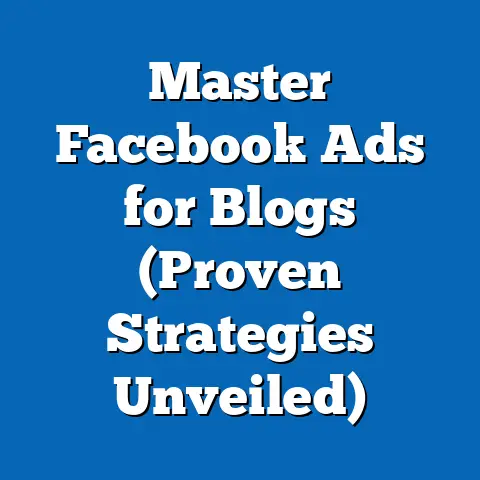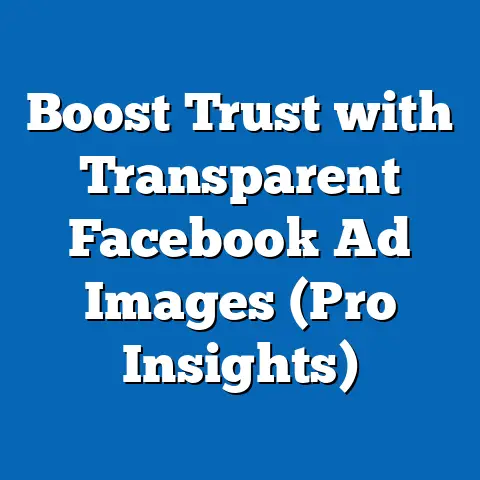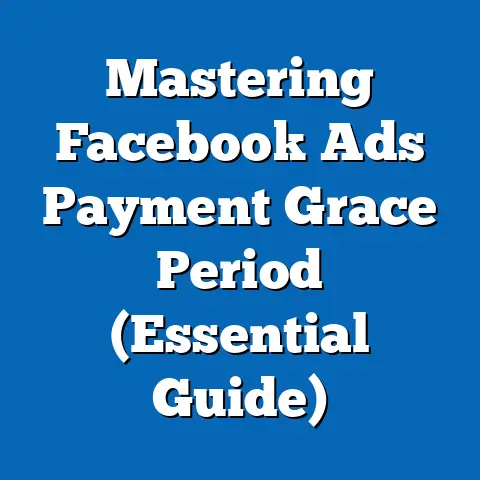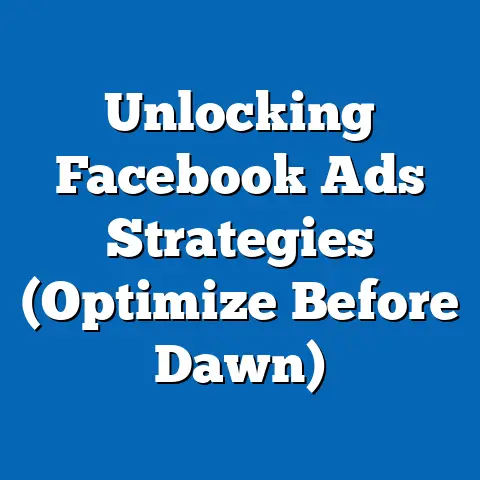Maximize Insights with Facebook Ads (Market Research Secrets)
In the ever-evolving world of digital marketing, the ability to adapt and refine strategies is crucial for long-term success. Facebook Ads, with its expansive reach and sophisticated targeting capabilities, offers a powerful platform for market research. However, many businesses only scratch the surface, focusing on immediate sales without realizing the potential for significant cost savings through strategic market research.
I’ve seen firsthand how a well-executed Facebook Ads campaign can not only drive conversions but also provide invaluable insights into customer behavior, preferences, and market trends. These insights, when acted upon, can lead to optimized campaigns, reduced wasted ad spend, and enhanced targeting precision, ultimately resulting in substantial long-term savings.
This article will explore how you can leverage Facebook Ads for comprehensive market research, unlocking the secrets to long-term savings and sustainable growth. Let’s dive in!
1. Understanding Facebook Ads for Market Research
Defining Facebook Ads and Their Role in Digital Marketing
Facebook Ads are paid advertisements displayed on Facebook and its partner networks, including Instagram, Messenger, and Audience Network. These ads allow businesses to target specific demographics, interests, behaviors, and locations, making them a highly effective tool for reaching potential customers. In digital marketing, Facebook Ads play a crucial role in driving traffic, generating leads, increasing brand awareness, and boosting sales.
How Facebook Ads Serve as a Powerful Tool for Market Research
Beyond their immediate marketing applications, Facebook Ads are an exceptional tool for market research. By running targeted ad campaigns, you can gather real-time data on how different audience segments respond to your messaging, creative elements, and offers. This data provides valuable insights into customer preferences, pain points, and unmet needs. I’ve personally used Facebook Ads to test different value propositions, identify emerging trends, and refine my understanding of target audiences.
Types of Market Insights Gathered Using Facebook Ads
Facebook Ads can provide a wealth of market insights, including:
- Demographic Data: Age, gender, location, education level, and other demographic information about your audience.
- Interest-Based Insights: The interests and hobbies of your target audience, gleaned from their Facebook activity.
- Behavioral Data: Their online behavior, purchase history, and device usage patterns.
- Ad Engagement Metrics: How users interact with your ads, including click-through rates (CTR), conversion rates, and cost per acquisition (CPA).
- Audience Feedback: Comments, shares, and reactions to your ads, providing qualitative feedback on your messaging and creative elements.
- A/B Testing Results: Data from A/B tests that help you understand which ad variations perform best with different audience segments.
Takeaway: Facebook Ads offer a versatile platform for gathering a wide range of market insights. By understanding the types of data available, you can tailor your campaigns to extract the most valuable information for your business.
2. The Financial Impact of Effective Market Research
Costs Associated with Poor Market Research and Ineffective Advertising
Poor market research can lead to a cascade of financial consequences, including:
- Wasted Ad Spend: Running campaigns that target the wrong audience or use ineffective messaging.
- Low Conversion Rates: Failing to convert ad clicks into sales or leads due to misalignment with customer needs.
- Poor Customer Acquisition Cost (CAC): Spending more to acquire a customer than the customer is worth in terms of lifetime value.
- Missed Opportunities: Overlooking potential market segments or product ideas due to a lack of understanding.
- Reputational Damage: Running tone-deaf or irrelevant ads that alienate potential customers.
I’ve seen businesses pour thousands of dollars into Facebook Ads without a clear understanding of their target audience, resulting in minimal ROI and significant frustration. These costs can be avoided with effective market research.
Statistics and Case Studies Illustrating Long-Term Financial Savings
Effective Facebook Ads-driven market research can lead to significant financial savings. Consider these statistics:
- Improved ROAS: Companies that conduct thorough market research are 38% more likely to achieve above-average profitability (CSO Insights).
- Reduced Ad Waste: Businesses that regularly analyze their ad data can reduce ad waste by up to 25% (MarketingProfs).
- Increased Conversion Rates: Optimized ad campaigns based on market research can increase conversion rates by 50% or more (HubSpot).
Case Study: A Local Restaurant Chain
A local restaurant chain was struggling to attract new customers through their Facebook Ads. After conducting thorough market research using Facebook Ads, they discovered that their target audience was primarily interested in healthy meal options and locally sourced ingredients. They then revised their ad messaging and creative elements to emphasize these aspects, resulting in a 40% increase in reservations and a 30% reduction in their cost per acquisition.
Correlation Between Well-Executed Market Research and Improved ROAS
The correlation between well-executed market research and improved ROAS is undeniable. By understanding your target audience, you can create ads that resonate with their needs and preferences, leading to higher click-through rates, conversion rates, and ultimately, a better return on your ad spend.
I remember working with an e-commerce client who initially saw a ROAS of around 2x. By implementing a more targeted approach based on Facebook Ads market research, we were able to identify high-value customer segments and tailor our ad messaging accordingly. Within a few months, their ROAS had increased to 5x, resulting in a significant boost to their bottom line.
Takeaway: Investing in effective market research through Facebook Ads can lead to substantial long-term financial savings by reducing ad waste, improving conversion rates, and increasing ROAS.
3. Setting Up Your Facebook Ads for Market Research
Step-by-Step Guide to Creating a Facebook Ads Account
- Create a Facebook Business Manager Account: Go to business.facebook.com and follow the instructions to create a Business Manager account. This is essential for managing your ad accounts and business assets.
- Create an Ad Account: Within Business Manager, create an ad account. You’ll need to provide your business information and payment details.
- Define Your Campaign Objectives: When creating a new campaign, choose an objective that aligns with your market research goals. Options like “Brand Awareness,” “Reach,” “Traffic,” and “Engagement” are often suitable for gathering insights.
Importance of Audience Targeting and Segmentation
Audience targeting and segmentation are critical for effective market research. Facebook Ads offers a wide range of targeting options, including:
- Demographics: Target users based on age, gender, education, and other demographic factors.
- Interests: Target users based on their interests, hobbies, and passions.
- Behaviors: Target users based on their online behavior, purchase history, and device usage.
- Custom Audiences: Upload your own customer lists to target existing customers or create Lookalike Audiences.
- Lookalike Audiences: Target users who share similar characteristics with your existing customers.
I’ve found that creating highly specific audience segments allows you to gather more granular insights and tailor your messaging accordingly. For example, you might create separate audience segments for millennials interested in sustainable products versus baby boomers interested in luxury goods.
Tools and Features Within Facebook Ads to Enhance Market Research
- Custom Audiences: Allows you to upload customer lists and target existing customers or create Lookalike Audiences. This is invaluable for understanding your current customer base.
- Lookalike Audiences: Helps you find new customers who share similar characteristics with your existing customers. This can reveal untapped market segments.
- A/B Testing: Allows you to test different ad variations, including headlines, images, and calls-to-action. This helps you understand which messaging resonates best with your target audience.
- Facebook Pixel: Tracks user behavior on your website after they click on your ad. This provides valuable insights into their purchase journey and conversion patterns.
- Audience Insights: Provides aggregated demographic and interest data about your target audience. This helps you refine your targeting and messaging.
Takeaway: Setting up your Facebook Ads account with a clear market research objective and utilizing the platform’s targeting and segmentation capabilities is essential for gathering valuable insights.
4. Leveraging Insights from Facebook Ads
Insights and Analytics Provided by Facebook Ads Manager
Facebook Ads Manager provides a comprehensive suite of analytics and reporting tools that allow you to track the performance of your ad campaigns. Key metrics include:
- Reach: The number of unique users who saw your ad.
- Impressions: The number of times your ad was displayed.
- Click-Through Rate (CTR): The percentage of users who clicked on your ad.
- Cost Per Click (CPC): The average cost you paid for each click on your ad.
- Conversion Rate: The percentage of users who completed a desired action after clicking on your ad.
- Cost Per Acquisition (CPA): The average cost you paid to acquire a new customer.
- Return on Ad Spend (ROAS): The revenue generated for every dollar spent on advertising.
Key Performance Indicators (KPIs) to Track for Market Research
For market research purposes, focus on these KPIs:
- Audience Engagement: Track comments, shares, and reactions to your ads to gauge audience sentiment.
- Ad Relevance Score: Indicates how relevant your ad is to your target audience. A high relevance score suggests that your ad is resonating well.
- Frequency: The average number of times a user saw your ad. Monitor frequency to avoid ad fatigue.
- Demographic Performance: Analyze how different demographic segments respond to your ads.
- Interest Performance: Identify which interests are most responsive to your messaging.
- Placement Performance: Determine which ad placements (e.g., Facebook News Feed, Instagram Stories) are most effective.
Interpreting Data from Facebook Ads to Inform Marketing Strategies and Product Development
Interpreting Facebook Ads data involves analyzing the performance of your ads across different audience segments and identifying patterns and trends. For example, if you notice that millennials are more responsive to video ads while baby boomers prefer image ads, you can tailor your ad creative accordingly.
I once worked with a skincare brand that used Facebook Ads to test different product concepts. By analyzing the engagement metrics and audience feedback, they discovered that there was a strong demand for a new anti-aging serum specifically formulated for sensitive skin. They then developed and launched the product, which quickly became a bestseller.
Takeaway: Facebook Ads Manager provides a wealth of data and analytics that can be used to inform your marketing strategies and product development efforts. By tracking the right KPIs and interpreting the data effectively, you can gain valuable insights into your target audience.
5. Creating Effective Ad Content for Market Research
Importance of Messaging and Creative Elements
The messaging and creative elements of your Facebook Ads play a crucial role in gathering market insights. Your ads should be designed to resonate with your target audience and encourage engagement. Consider these best practices:
- Use Compelling Headlines: Capture attention and pique interest.
- Write Clear and Concise Copy: Communicate your message effectively.
- Use High-Quality Images and Videos: Visually appealing content attracts attention.
- Include a Clear Call-to-Action: Tell users what you want them to do.
- Tailor Your Messaging to Each Audience Segment: Speak to their specific needs and interests.
Tips on Designing Ads That Resonate with Target Audiences
- Know Your Audience: Understand their pain points, desires, and motivations.
- Use Language They Understand: Avoid jargon and technical terms.
- Showcase Benefits, Not Just Features: Explain how your product or service solves their problems.
- Use Social Proof: Include testimonials, reviews, and case studies.
- Create a Sense of Urgency: Encourage immediate action.
I’ve found that using customer-generated content in Facebook Ads can be highly effective. By featuring real customers using and enjoying your product, you can build trust and credibility.
Successful Examples of Ad Campaigns That Effectively Gathered Market Research Data
- Poll-Based Ads: Run ads that ask users to vote on their favorite product features or preferences.
- Question-Based Ads: Ask users open-ended questions about their needs and challenges.
- Quiz-Based Ads: Create quizzes that help users assess their needs and preferences.
- Offer-Based Ads: Offer a discount or free sample in exchange for feedback or participation in a survey.
Example: A Fitness App
A fitness app ran a Facebook Ad campaign that asked users to vote on their preferred workout style (e.g., yoga, HIIT, strength training). By analyzing the results, they discovered that there was a strong demand for yoga-based workouts among their target audience. They then created a new series of yoga workouts, which quickly became one of their most popular offerings.
Takeaway: Creating effective ad content that resonates with your target audience is essential for gathering valuable market insights. By using compelling messaging, high-quality visuals, and clear calls-to-action, you can encourage engagement and gather valuable feedback.
6. Analyzing and Applying Data from Facebook Ads
Guide on Analyzing Data Gathered from Ad Campaigns
Analyzing Facebook Ads data involves several steps:
- Define Your Objectives: Clearly define what you want to learn from your data.
- Gather Your Data: Export your Facebook Ads data into a spreadsheet or data visualization tool.
- Clean Your Data: Remove any errors or inconsistencies.
- Analyze Your Data: Look for patterns and trends.
- Visualize Your Data: Create charts and graphs to help you understand your data.
Methods for Translating Insights into Actionable Strategies
- Refine Your Targeting: Use your data to refine your audience targeting and segmentation.
- Optimize Your Messaging: Tailor your ad messaging to resonate with your target audience.
- Improve Your Creative Elements: Use your data to inform your ad creative.
- Adjust Your Bidding Strategy: Optimize your bidding strategy to maximize your ROI.
- Test New Ideas: Use your data to generate new ideas for ad campaigns and product development.
Ways to Iterate and Optimize Campaigns Based on Data Collected
- A/B Testing: Continuously test different ad variations to identify what works best.
- Audience Segmentation: Create highly specific audience segments based on your data.
- Campaign Budget Optimization (CBO): Use CBO to allocate your budget to the best-performing ad sets.
- Ad Scheduling: Run your ads during the times when your target audience is most active.
- Placement Optimization: Focus on the ad placements that are most effective.
I always recommend setting up a regular review process to analyze your Facebook Ads data and implement changes based on your findings. This will help you continuously improve the performance of your campaigns and maximize your ROI.
Takeaway: Analyzing and applying data from Facebook Ads is essential for optimizing your campaigns and gathering valuable market insights. By translating your insights into actionable strategies, you can continuously improve your results and drive long-term savings.
7. Case Studies: Success Stories of Brands Using Facebook Ads for Market Research
Real-Life Examples of Brands Using Facebook Ads for Market Research
- Netflix: Uses Facebook Ads to test different movie and TV show trailers with various audience segments.
- Airbnb: Uses Facebook Ads to identify new travel destinations and target potential customers.
- Spotify: Uses Facebook Ads to promote new music and podcasts to specific audience segments.
- Warby Parker: Uses Facebook Ads to test different eyeglass styles and gather feedback from potential customers.
Strategies Employed, Insights Gained, and Resulting Long-Term Savings
- Netflix: By testing different trailers, Netflix can optimize their marketing campaigns and increase viewership, resulting in higher subscription rates and lower churn.
- Airbnb: By identifying new travel destinations, Airbnb can expand their inventory and attract new customers, resulting in higher revenue and market share.
- Spotify: By promoting new music and podcasts to specific audience segments, Spotify can increase engagement and drive subscription growth, resulting in higher revenue and profitability.
- Warby Parker: By testing different eyeglass styles, Warby Parker can optimize their product development and marketing efforts, resulting in higher sales and customer satisfaction.
Lessons Learned and Best Practices from Case Studies
- Focus on Your Objectives: Clearly define what you want to learn from your market research.
- Target Your Audience: Create highly specific audience segments.
- Test Different Variations: A/B test different ad variations to identify what works best.
- Analyze Your Data: Track your key performance indicators and look for patterns and trends.
- Take Action: Implement changes based on your findings.
I’ve learned from these case studies that the key to success with Facebook Ads market research is to have a clear understanding of your objectives, a well-defined target audience, and a willingness to experiment and iterate.
Takeaway: Studying successful case studies can provide valuable insights into how to leverage Facebook Ads for market research. By learning from the experiences of other brands, you can improve your own strategies and achieve long-term savings.
8. Future Trends in Facebook Ads and Market Research
Emerging Trends in Digital Advertising and Market Research
- Artificial Intelligence (AI): AI is being used to automate ad creation, optimize targeting, and personalize ad experiences.
- Augmented Reality (AR): AR is being used to create immersive ad experiences that allow users to try on products virtually.
- Personalized Advertising: Ads are becoming more personalized based on user data and preferences.
- Video Advertising: Video ads are becoming more popular and effective.
- Mobile Advertising: Mobile advertising continues to grow as more users access the internet on their smartphones.
How Facebook Ads May Evolve in the Context of Market Research
- More Sophisticated Targeting: Facebook Ads may offer more granular targeting options based on user data and behavior.
- Advanced Analytics: Facebook Ads may provide more advanced analytics and reporting tools.
- Integration with Other Platforms: Facebook Ads may integrate with other marketing platforms, such as CRM and email marketing systems.
- AI-Powered Optimization: AI may be used to automatically optimize ad campaigns based on real-time data.
- Interactive Ad Formats: Facebook Ads may offer more interactive ad formats, such as quizzes and polls.
Staying Ahead of the Curve by Adapting Strategies
To stay ahead of the curve, you should:
- Stay Informed: Keep up with the latest trends and best practices in digital advertising and market research.
- Experiment with New Features: Try out new Facebook Ads features as they become available.
- Invest in Training: Invest in training for yourself and your team.
- Network with Other Marketers: Share ideas and learn from others.
- Be Agile: Be willing to adapt your strategies as the landscape changes.
I believe that the future of Facebook Ads market research is bright. As technology continues to evolve, we will have access to even more powerful tools and insights that can help us understand our target audience and drive long-term savings.
Takeaway: Staying ahead of the curve by adapting your strategies to emerging trends is essential for maximizing the value of Facebook Ads for market research.
9. Conclusion: The Path to Long-Term Savings through Market Research with Facebook Ads
Throughout this article, I’ve highlighted the importance of using Facebook Ads not just for immediate marketing gains, but also as a strategic tool for market research. By understanding your target audience, creating effective ad content, analyzing your data, and staying ahead of the curve, you can unlock significant long-term savings and drive sustainable growth.
Investing in effective market research through Facebook Ads is an investment in your business’s future. It allows you to make informed decisions, optimize your campaigns, and ultimately achieve a better return on your ad spend. Don’t just see Facebook Ads as a way to generate immediate sales; see it as a powerful tool for understanding your customers and building a thriving business.
Now, I encourage you to take action and implement the insights you’ve gained from this article. Start by setting up a Facebook Ads account with a clear market research objective, and begin gathering valuable data that can inform your marketing strategies and product development efforts.
Takeaway: Investing in effective market research through Facebook Ads can yield significant long-term savings and sustainable growth.
Call to Action:
I’d love to hear about your experiences with Facebook Ads for market research. Share your thoughts, tips, and success stories in the comments below! Let’s learn and grow together as a community.






